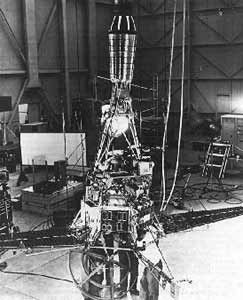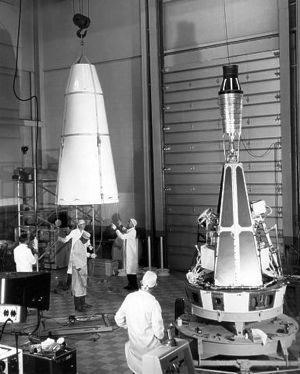
Home - Search - Browse - Alphabetic Index: 0- 1- 2- 3- 4- 5- 6- 7- 8- 9
A- B- C- D- E- F- G- H- I- J- K- L- M- N- O- P- Q- R- S- T- U- V- W- X- Y- Z
Ranger 1-2
 Ranger 1, 2 Credit: NASA |
Status: Operational 1961. First Launch: 1961-08-23. Last Launch: 1961-11-18. Number: 2 . Gross mass: 305 kg (672 lb).
The primary mission of the early Ranger flight models was to test the performance of those functions and parts that were necessary for carrying out later lunar (Ranger) and planetary (Mariner) missions using the same spacecraft bus. A secondary objective was to study the nature of particles and fields in interplanetary space.
The spacecraft consisted of a hexagonal base upon which were mounted the spacecraft experiments, two solar panels, and high-and low-gain antennas. Instruments aboard the spacecraft included a Lyman-alpha telescope, a rubidium-vapor magnetometer, electrostatic analyzers, medium-energy-range particle detectors, two triple coincidence telescopes, a cosmic-ray integrating ionization chamber, cosmic dust detectors, and scintillation counters. Two 960-mhz transmitters were aboard the spacecraft, one with 0.25 W power output and the other with 3 W power output.
Family: Lunar Crashers, Moon. Country: USA. Launch Vehicles: Atlas, Atlas SLV-3 Agena B, Atlas Agena B. Projects: Ranger. Launch Sites: Cape Canaveral, Cape Canaveral LC12. Agency: JPL, NASA. Bibliography: 16, 18, 2, 278, 296, 4046, 4047, 4050, 4051, 6.
 | Ranger 1 Credit: Manufacturer Image |
 | Ranger A Ranger A in assembly at JPL, Pasadena |
1961 May 29 - . LV Family: Atlas. Launch Vehicle: Atlas SLV-3 Agena B.
- Ranger 1 booster erected. - . Nation: USA. Program: Ranger. Class: Moon. Type: Lunar probe. Spacecraft Bus: Ranger. Spacecraft: Ranger 1-2. Atlas booster 111-D, to be used for Ranger I, was erected on the launch pad at Cape Canaveral..
1961 July 12 - .
- First large space simulator in the United States - .
Nation: USA.
Program: Ranger.
Spacecraft Bus: Ranger.
Spacecraft: Ranger 1-2.
Jet Propulsion Laboratory announced that construction was under way on the first large space simulator in the United States capable of testing full-scale spacecraft of the Ranger and Mariner classes. Three primary space effects could be simulated: solar radiation, cold space heat sink, and a high vacuum equivalent to about one part in a billion of the atmospheric pressure at sea level.
1961 August 23 - . 10:04 GMT - . Launch Site: Cape Canaveral. Launch Complex: Cape Canaveral LC12. LV Family: Atlas. Launch Vehicle: Atlas Agena B. FAILURE: Agena B second stage failure.. Failed Stage: U.
- Ranger 1 - .
Payload: NASA P-32 (RA-1). Mass: 306 kg (674 lb). Nation: USA.
Agency: NASA.
Program: Ranger.
Class: Moon.
Type: Lunar probe. Spacecraft Bus: Ranger.
Spacecraft: Ranger 1-2.
Decay Date: 1961-08-30 . USAF Sat Cat: 173 . COSPAR: 1961-Phi-1. Apogee: 446 km (277 mi). Perigee: 179 km (111 mi). Inclination: 32.90 deg. Period: 90.60 min.
Lunar probe; failed to leave Earth orbit. Ranger 1, a test version of the spacecraft which would attempt an unmanned crash landing on the moon, was launched from the Atlantic Missile Range by an Atlas-Agena B booster. The 306 kg spacecraft did not attain the scheduled extremely elongated orbit because of the misfiring of the Agena B rocket. Although the spacecraft systems were tested successfully, only part of the eight project experiments could be carried out. Ranger 1 reentered on August 29 after 111 orbits. Ranger 1's primary mission was to test the performance of those functions and parts that are necessary for carrying out subsequent lunar and planetary missions using essentially the same spacecraft design.
1961 November 18 - . 08:12 GMT - . Launch Site: Cape Canaveral. Launch Complex: Cape Canaveral LC12. LV Family: Atlas. Launch Vehicle: Atlas Agena B. FAILURE: Agena B Second Stage failed to restart.. Failed Stage: U.
- Ranger 2 - .
Payload: NASA P-33 (RA-2). Mass: 304 kg (670 lb). Nation: USA.
Agency: NASA.
Program: Ranger.
Class: Moon.
Type: Lunar probe. Spacecraft Bus: Ranger.
Spacecraft: Ranger 1-2.
Decay Date: 1961-11-20 . USAF Sat Cat: 206 . COSPAR: 1961-A-Theta-1. Apogee: 242 km (150 mi). Perigee: 150 km (90 mi). Inclination: 33.30 deg. Period: 88.30 min.
This was a flight test of the Ranger spacecraft system designed for future lunar and interplanetary missions. The spacecraft was launched into a low earth parking orbit, but an inoperative roll gyro prevented Agena restart resulting in Ranger 2 being stranded in low earth orbit. The orbit decayed and the spacecraft reentered Earth's atmosphere on 20 November 1961.
Back to top of page
Home - Search - Browse - Alphabetic Index: 0- 1- 2- 3- 4- 5- 6- 7- 8- 9
A- B- C- D- E- F- G- H- I- J- K- L- M- N- O- P- Q- R- S- T- U- V- W- X- Y- Z
© 1997-2019 Mark Wade - Contact
© / Conditions for Use